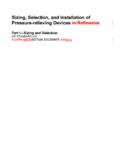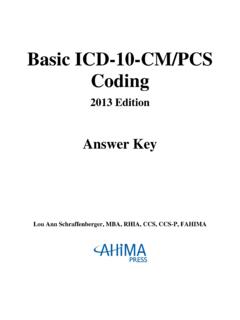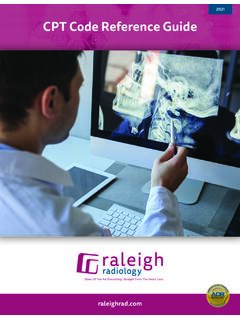Transcription of PRESSURE SAFETY RELIEF VALVES
1 PRESSURE SAFETY RELIEF VALVESTECHNICAL BULLETIN 3 PRESSURE SAFETY RELIEF VALVES TECHNICAL BULLETIN 3-I TECHNICAL BULLETIN 3-I PRESSURE SAFETY RELIEF VALVES 1 0. FOREWORD This technical bulletin is dedicated to those PRESSURE relieving devices which fall within the definition of direct-loaded SAFETY VALVES , produced by PARCOL since the beginning of the Seventies. The information contained in this document derive from PARCOL experience and internal instructions and are basically in accordance with the international standards listed in the following paragraph. 1. NORMATIVE REFERENCE API STANDARD 520 Part I (2008), Sizing, Selection and Installation of PRESSURE -relieving Devices in Refineries Sizing and selection API RECOMMENDED PRACTICE 520 Part II (2003), Sizing, Selection and Installation of PRESSURE -relieving Devices in Refineries Installation API STANDARD 526 (2009), Flanged Steel PRESSURE - RELIEF VALVES API STANDARD 527 (1991), Seat tightness of PRESSURE - RELIEF VALVES ISO 4126-1 (2004), SAFETY devices for protection against excessive PRESSURE SAFETY VALVES ISO 4126-7 (2004), SAFETY devices for protection against excessive PRESSURE Common data ISO 4126-9 (2008)
2 , SAFETY devices for protection against excessive PRESSURE Application and installation of SAFETY devices excluding stand-alone bursting disc SAFETY devices ISO-WD 4126-11 (2011), SAFETY devices for protection against excessive PRESSURE Performance testing 2. TERMS AND DEFINITIONS Direct loaded SAFETY valve SAFETY valve in which the loading due to the fluid PRESSURE underneath the valve disc is opposed only by a direct mechanical loading device such as a weight, lever and weight, or a spring. SAFETY valve Automatic PRESSURE -relieving device actuated by the static PRESSURE upstream of the valve and characterized by a rapid full opening or pop action. It is normally used for gas or vapour service. RELIEF valve Automatic PRESSURE -relieving device actuated by the static PRESSURE upstream of the valve.
3 The valve opens in proportion to the increase in PRESSURE over the opening PRESSURE . It is primarily used for liquid service. SAFETY - RELIEF valve Automatic PRESSURE relieving device actuated by the static PRESSURE upstream the valve. It is suitable for use as either a SAFETY or RELIEF valve, depending on the application. Max allowable working PRESSURE (MAWP) Maximum allowable working PRESSURE for operation, in accordance to manufacturing codes and service conditions adopted as the basis for design. Accumulation PRESSURE increase over the MAWP value, expressed as percentage of the MAWP PRESSURE , allowed in the pressurized system. Maximum allowable accumulations are established by applicable codes for operating and fire contingencies. Set PRESSURE (pset) Predetermined PRESSURE at which a SAFETY valve under operating conditions commences to open.
4 It is expressed in gauge units. Three different ways may be used to detect the set PRESSURE depending on the assigned definition: - start of opening, which may be checked measuring the lift or hearing/seeing a continuous outflow; - opening PRESSURE , easily recognizable by the sudden movement of the disc (applicable only to compressible fluids); - start-to-leak PRESSURE , may be easily detected as soon as the first bubble or drop comes out (applicable only to VALVES having a perfect seal, with resilient seats). PRESSURE SAFETY RELIEF VALVES TECHNICAL BULLETIN 3-I 2 Cold-differential test PRESSURE PRESSURE at which the valve is adjusted to open on the test bench, including the corrections for service conditions of back PRESSURE , temperature, or both. Overpressure (ovp) PRESSURE increase over the set PRESSURE , at which the SAFETY valve attains the lift specified by the manufacturer, usually expressed as a percentage of the set PRESSURE .
5 It is the overpressure used to certify the SAFETY valve. Relieving PRESSURE (p1) PRESSURE used for the sizing of a SAFETY valve which is greater than or equal to the set PRESSURE plus overpressure. Lift Actual travel of the valve disc away from the closed position. Coefficient of discharge Value of actual flowing capacity (from tests, by Manufacturer) divided by the theoretical flowing capacity (from calculation). Blowdown (bd) Difference between the set PRESSURE and the reseating PRESSURE , usually expressed as percentage of the set PRESSURE . Back PRESSURE (pb) PRESSURE on the discharge side of SAFETY - RELIEF valve, due to the PRESSURE existing in the downstream system. It is the sum of the built-up and of the superimposed back PRESSURE . It is expressed as: - percentage of relieving PRESSURE , calculated in absolute units for compressible fluids and in gauge units for incompressible fluids, according to ISO 4126; - percentage of set PRESSURE , calculated in gauge units, according to API.
6 Built-up back PRESSURE PRESSURE existing at the outlet of a SAFETY valve caused by flow through the valve and the discharge system. Superimposed back PRESSURE PRESSURE existing at the outlet of a SAFETY valve at the time when the device is required to operate. It may be constant or variable. Flow area Minimum cross-sectional flow area between inlet and seat used to calculate the theoretical flow capacity. TECHNICAL BULLETIN 3-I PRESSURE SAFETY RELIEF VALVES 3 3. DESCRIPTION AND OPERATING CRITERIA SAFETY - RELIEF VALVES may be considered as stop VALVES that close using a steady force insisting directly on the disc , thus no external actuator is needed. When fitted in a pressurized system, they remain normally closed and open only if the force generated by the PRESSURE is higher than the corresponding thrust insisting on the disc .
7 SAFETY VALVES are conceived to keep the PRESSURE of the system, where they are fitted, under a stated value by discharging as much fluid as necessary for this purpose. The force on the disc may be imposed through: a weight, a weight and a lever, a spring. Weight loaded VALVES have a lift higher (and thus a higher flow) than spring loaded VALVES , being all other conditions unchanged, because the latter reacts proportionally to the lift while the former has a constant opposite force. On the other hand, weight loaded VALVES have some disadvantages due to the inertial effect of the moving parts, which limits their use to light duties with low set PRESSURE . Direct spring loaded SAFETY - RELIEF VALVES may be distinguished into two main types: - conventional VALVES , - balanced VALVES . Conventional non-balanced VALVES Conventional non-balanced VALVES are applicable when no back PRESSURE exists on the discharge side or when the back PRESSURE does not alter the set PRESSURE and the performance of the valve beyond known limits.
8 In practice they may be used without problems in case of atmospheric discharge. They may have an open spring bonnet ( vented) or a closed one, connected to the valve discharge. The closed type is allowable also for service on liquids or anyway when the fluid must not be spread outside On open bonnet types, the influence of back PRESSURE is negligible because they normally have a free air discharge. In case of conveyed discharge, the possible back PRESSURE may increase or decrease the set PRESSURE depending on the valve design. This kind of valve is usually fit on compressed air lines, where external leakages are acceptable, or far service on boiler or steam lines, where it is necessary to protect the spring from excessive heating Balanced VALVES The valve disc balancing is necessary when a variable or unpredictable back PRESSURE exists, as for instance in petrochemical plants where all process fluid discharges must be conveyed for SAFETY or environmental reasons.
9 If then Fig. 1 Principle of balancing of SAFETY - RELIEF VALVES In the conventional design the valve body is closed and connected to the valve discharge so that the back PRESSURE P2 increases the spring force. In the bellows type balanced valve, no PRESSURE exists inside the bellows and this excludes the effect of the back PRESSURE P2. In piston type balanced valve, the back PRESSURE P2 downwards is equalized by the PRESSURE on the piston which has the same area as the nozzle seat. PRESSURE SAFETY RELIEF VALVES TECHNICAL BULLETIN 3-I 4 In conventional VALVES , if the spring bonnet is vented to the discharge, the back PRESSURE acts with the spring PRESSURE on the whole surface of the disc retainer so as to increase the opening PRESSURE (over the set PRESSURE ). Balanced VALVES are designed in such a way to exclude the unbalanced area from the effect of the back PRESSURE and vent it to atmosphere (see fig.)
10 1). This is normally achieved by fitting a metallic bellows between disc retainer and valve body. The bellows area is fairly equal to the nozzle seat area. The bellows length is sized to allow the valve lift without being compressed too much. Its assembling to the disc retainer is done in several manners taking into account that a good seal must always be performed towards the valve bonnet. The upper part of the bellows has the shape of a disc which is blocked between spring bonnet and valve body and is nearly adherent to the supporting guide. In other models the balance of the disc retainer is performed by a piston solidly connected to the stem and having the same diameter of the nozzle seat. The balancing bellows allows also for the isolation of the spring from the process fluid. Sometimes this model is required for corrosive fluids for which there is no compatibility with the material of the spring.








